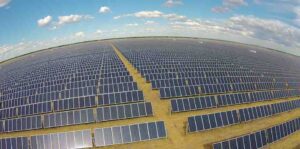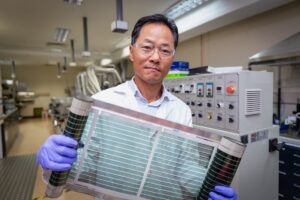Twelve start ups out of 270 applicants have been recognised by BloomergNEF as potential game changers in the shift to clean energy.
The latest announcement of the decade-old BNEF Pioneers program identifies a range of different technology proposals, from grid storage to aviation to carbon removal and a group of “wild cards.”
BNEF analysts chose the 12 game changers from more than 270 applications from 27 countries, including Australian solar thermal technology developer Vast Solar.
They were judged on the potential impact on greenhouse gas emissions and the planet, the degree of technology innovation and novelty, and the likelihood of adoption and potential scalability.
Not all of the past choices work out. Australia’s DyeSol and California’s solar thermal company Brightsource Energy, for instance, both fell by the wayside, but others have done well, including Germany’s sonnenBatterie and Australia’s Building IQ
No Australian company made the final listing this year, but this is a rundown of the companies that did, in their various categories.
Challenge 1: Providing round-the-clock zero-emissions power
Energy Dome (Italy) invented a CO2 battery to make long-duration energy storage an economically viable proposition. Utilising a closed thermodynamic process, Energy Dome’s CO2 battery stores electricity cost effectively with what they describe as “unprecedented round trip efficiencies and without emissions to the atmosphere.”
“We believe that our approach, relying on tried and tested components, combined with a low cost and high efficiency, paves the way for rapid adoption of the CO2 Battery in the global power sector,” said Claudio Spadacini, CEO of Energy Dome.
“We believe that the CO2 Battery will help to significantly accelerate the energy transition by replacing baseload fossil fuels with fully dispatchable solar and wind energy.”
Kairos Power (US) developed a novel advanced nuclear reactor technology to complement renewable energy sources. The Kairos Power fluoride salt-cooled high temperature reactor (KP-FHR) was designed to be cost-competitive with natural gas in the United States electricity market and to provide a long-term reduction in cost.
“We believe nuclear power is necessary to fight climate change and we must deliver a cost-competitive and safe technology to achieve our mission of enabling the world’s transition to clean energy,” said Mike Laufer, CEO of Kairos Power.
“Kairos Power’s dedicated team is working hard every day to solve difficult problems and accomplish a feat that has never been done before. We are grateful to have BNEF Pioneers award recognition as we progress on our path toward commercialization.”
Nuvve (U.S.) offers a vehicle-to-grid (V2G) technology to manage power among EV batteries and the grid. Billing themselves as “the only electric fleet service featuring high-powered, vehicle-to-grid (V2G) charging with 24/7 maintenance and intelligent energy management on a global, commercially available platform,” Nuvve offers 100% financing and no upfront costs.
“As the electrification of everything unfolds simultaneously with decarbonization, the challenge of synchronizing energy production with load becomes more complex,” said Gregory Poilasne, CEO, Nuvve.
“At Nuvve, we’re focused on intelligently electrifying the planet and are grateful for our ecosystem of partners and customers who are aligning with us to blaze a new path – a path for the world to follow.”
Reactive Technologies (UK) helps grid operators, electric utilities, and regulators to measure grid inertia more accurately. The company describes itself as “a highly innovative energy tech company providing grid operators and renewable asset owners with market-leading and mission-critical technology solutions to accelerate the clean energy transition.”
“By supporting resilience for power grids, throughout the transition to 100% continuous clean energy, with first-of-its-kind real-time grid measurement data, we aim to help as many operators and utilities as possible get to net zero safer and faster,” said Marc Borrett, CEO, Reactive Technologies.
Challenge 2: Scaling long-term carbon removal technologies
Carbfix (Iceland) provides a natural and permanent CO2 storage solution by capturing CO2 and turning it into stone underground in less than two years.
“The award comes at an exciting time for Carbfix, as we work towards implementing our proven technology on a significantly larger scale than before,” said Edda Aradottir, CEO, Carbfix.
“The potential for applying permanent CO2 mineral storage in basalts around the globe is enormous, and increasingly being recognized. We are very much looking forward to maximizing the impact of the Carbfix technology in coming years.”
Climate Robotics (US) developed agricultural implements to produce biochar – a soil amendment that improves soil health while sequestering carbon. The technology is based around automation and mechanisation, along with existing carbon sequestration technologies.
“At Climate Robotics, we are developing solutions to durably sequester atmospheric carbon in the soil as biochar, while improving the economics of commercial row-crop agriculture,” said Jason Aramburu, CEO, Climate Robotics.
“By deploying our equipment on farms around the world, we will sustainably increase global soil health while sequestering over 1 billion tonnes of CO2 each year.”
Verdox’s (US) technology removes CO2 from industrial emissions and the air with 70% energy savings versus conventional approaches. Using only electricity, Verdox’s technology platform is capable of removing carbon dioxide both directly from the air and from emission sources.
“We believe carbon removal will be essential to humanity’s sustainable development, but it will never be deployed at a significant scale if the required energy and cost cannot be reduced significantly,” said Brian Baynes, CEO, Verdox.
“We launched Verdox two years ago on the promise of our novel electrochemical carbon capture system, which has been shown to reduce the energy penalty for capture by up to 70%. The future of carbon removal will be electric.”
Challenge 3: Decarbonizing aviation
Twelve (U.S.) transforms captured CO2 into critical chemicals, which can then be made into materials and fuels, using a patented CO2 PEM electrolyser. Instead of sourcing carbon – necessary for chemical production – from fossil fuels, Twelve sources it straight from CO2, by replacing the fossil carbon in critical chemicals with renewable, recycled carbon from CO2.
“Addressing the climate crisis will require new, innovative technologies in all sectors,” said Nicholas Flanders, CEO, Twelve.
“As we scale and develop new partnerships with globally-leading brands in some of the hardest-to-abate industries, we are helping companies address emissions and pave the way for a fossil-free future.”
ZeroAvia (US) designs and develops zero-emission, hydrogen-electric aviation powertrains, targeting a 500-mile range for a 10–20 seat aircraft.
“We are initially targeting the regional commercial aviation market with our hydrogen-electric powertrain for 19-seat aircraft with trips up to 500 miles,” said Valery Miftakhov, CEO, ZeroAvia.
“However, as we scale, we will implement the technology into larger aircraft and be able to fly for longer trips. We believe that with our zero-emission technology, we can reduce life cycle greenhouse gas emissions by more than 90 per cent and simultaneously substantially reduce operating costs, thus enabling more people to fly with all of the positive societal impacts that brings.”
Wildcards
Addionics’s (Israel) 3D electrodes increase energy density and power, enhance safety, extend lifetime, and lower the cost for lithium-ion batteries with any chemistry. With a 50% reduction in charging time and a lifetime up to 150% longer, Addionic’s battery technologies is also reducing battery costs.
“Better performing, safer and cheaper batteries are integral to increasing EV adoption and realizing a net zero future,” said Moshiel Biton, CEO, Addionics.
“With the support of our OEM and supplier partners, we look forward to accelerating our product development and laying the groundwork for commercialization in support of global electrification.”
Blue Frontier (US) combines efficient building air conditioning products with integral, low-cost energy storage. Offering a replacement for the Packaged Rooftop Units that dominate the commercial building air conditioning market, Blue Frontier’s products offer a 60% reduction in yearly electricity use and 80% reduction in peak electricity demand.
“We at Blue Frontier are developing next-generation air conditioners that not only have dramatically higher efficiencies than conventional units, but also intelligently shift their electricity consumption to match grid renewable energy generation, without compromising the comfort of building occupants,” said Daniel Betts, CEO, Blue Frontier.
“Widespread deployment of our units will fundamentally change the load shape of buildings, making them compatible with low-cost net-zero grids. This is an enormous mission and through this award BloombergNEF and its partners are lending us a big hand in helping us achieve it.”
Carbon Clean’s (UK) technology reduces the costs of carbon capture when compared to existing solutions thanks to modular carbon capture technology with 90%+ capture rates delivering industrial quality CO2 for re-use or sequestration.
“Carbon Clean is revolutionising industrial decarbonisation for essential hard-to-abate industries such as cement, steel, refineries and energy from waste,” said Aniruddha Sharma, CEO, Carbon Clean.
“Our latest breakthrough product, CycloneCC, reduces the size of carbon capture technology by 10x and physical footprint by 5x. Inclusion in the program reinforces the impact we’re making to enable capturing 1 billion tonnes of CO2.”










